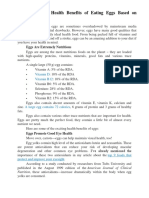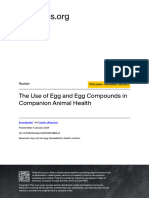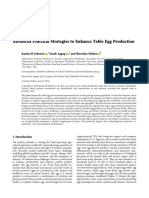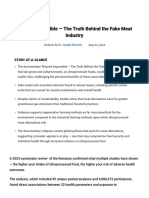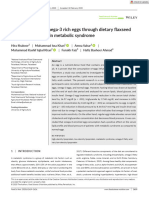Eggs Are Laid by Females of Many Different Species
Eggs Are Laid by Females of Many Different Species
Uploaded by
Dinesh KumarCopyright:
Available Formats
Eggs Are Laid by Females of Many Different Species
Eggs Are Laid by Females of Many Different Species
Uploaded by
Dinesh KumarOriginal Description:
Original Title
Copyright
Available Formats
Share this document
Did you find this document useful?
Is this content inappropriate?
Copyright:
Available Formats
Eggs Are Laid by Females of Many Different Species
Eggs Are Laid by Females of Many Different Species
Uploaded by
Dinesh KumarCopyright:
Available Formats
EGGS
Eggs are laid by females of many different species, including birds, reptiles, amphibians, and fish, and have been eaten by mankind for thousands of years.[1] Bird and reptile eggs consist of a protective eggshell, albumen (egg white), and vitellus (egg yolk), contained within various thin membranes. Popular choices for egg consumption are chicken, duck, quail, roe, and caviar, but the egg most often consumed by humans is the chicken egg, by a wide margin. Egg yolks and whole eggs store significant amounts of protein and choline,[2][3] and are widely used in cookery. Due to their protein content, the United States Department of Agriculture (USDA) categorizes eggs as Meats within the Food Guide Pyramid.[2] Despite the nutritional value of eggs, there are some potential health issues arising from egg quality, storage, and individual allergies. Chickens and other egg-laying creatures are widely kept throughout the world, and mass production of chicken eggs is a global industry. In 2009, an estimated 62.1 million metric tons of eggs were produced worldwide from a total laying flock of approximately 6.4 billion hens.[4] There are issues of regional variation in demand and expectation, as well as current debates concerning methods of mass production, with the European Union's ban on battery farming of chickens.
Cooking substitutes For those who do not consume eggs, alternatives used in baking include other rising agents or binding materials, such as ground flax seeds or potato starch flour. Tofu can also act as a partial binding agent, since it is high in lecithin due to its soy content. Applesauce can be used, as well as arrowroot and banana. Extracted soybean lecithin, in turn, is often used in packaged foods as an inexpensive substitute for egg-derived lecithin. Other egg substitutes are made from just the white of the egg for those who worry about the high cholesterol and fat content in eggs. These products usually have added vitamins and minerals, as well as vegetable-based emulsifiers and thickeners such as xanthan gum or guar gum. These allow the product to maintain the nutrition and several culinary properties of real eggs, making possible foods such as Hollandaise sauce, custard, mayonnaise, and most baked goods with these substitutes. Nutritional value Chicken egg whole, hard-boiled Nutritional value per 100 g (3.5 oz) Energy Carbohydrates Fat 647 kJ (155 kcal) 1.12 g 10.6 g
Protein - Tryptophan - Threonine - Isoleucine - Leucine - Lysine - Methionine - Cystine - Phenylalanine - Tyrosine - Valine - Arginine - Histidine - Alanine - Aspartic acid
12.6 g 0.153 g 0.604 g 0.686 g 1.075 g 0.904 g 0.392 g 0.292 g 0.668 g 0.513 g 0.767 g 0.755 g 0.298 g 0.700 g 1.264 g
- Glutamic acid - Glycine - Proline - Serine Water Vitamin A equiv. Thiamine (vit. B1) Riboflavin (vit. B2) Pantothenic acid (B5) Folate (vit. B9) Vitamin B12 Choline Vitamin D Vitamin E Calcium
1.644 g 0.423 g 0.501 g 0.936 g 75 g 149 g (19%) 0.066 mg (6%) 0.5 mg (42%) 1.4 mg (28%) 44 g (11%) 1.11 g (46%) 294 mg (60%) 87 IU (15%) 1.03 mg (7%) 50 mg (5%)
Iron Magnesium Phosphorus Potassium Zinc Cholesterol
1.2 mg (9%) 10 mg (3%) 172 mg (25%) 126 mg (3%) 1.0 mg (11%) 424 mg
For edible portion only. Refuse: 12% (shell). One large egg is 50 grams. Percentages are relative to US recommendations for adults. Source: USDA Nutrient Database Eggs add protein to a person's diet, as well as various other nutrients. Chicken eggs are the most commonly eaten eggs. They supply all essential amino acids for humans (a source of 'complete protein'),[24] and provide several vitamins and minerals, including retinol[25] (vitamin A), riboflavin (vitamin B2), folic acid (vitamin B9), vitamin B6, vitamin B12, choline, iron,calcium, phosphorus and potassium. Although not as abundant as red meats, eggs are a source of CoQ10 depending on how they are prepared.[26]
All of the egg's vitamins A, D, and E are in the egg yolk. The egg is one of the few foods to naturally contain vitamin D. A large egg yolk contains approximately 60 Calories (250 kilojoules); the egg white contains about 15 Calories (60 kilojoules). A large yolk contains more than two-thirds of therecommended daily intake of 300 mg of cholesterol (although one study indicates the human body may not absorb much cholesterol from eggs[27]). The yolk makes up about 33% of the liquid weight of the egg. It contains all of the fat, slightly less than half of the protein, and most of the other nutrients. It also contains all of the choline, and one yolk contains approximately half of the recommended daily intake. Choline is an important nutrient for development of the brain, and is said to be important for pregnant and nursing women to ensure healthy fetal brain development.[28] The diet of the laying hens can greatly affect the nutritional quality of the eggs. For instance, chicken eggs that are especially high in omega 3 fatty acids are produced by feeding laying hens a diet containing polyunsaturated fats and kelp meal. Pasture-raised free-range hens which forage largely for their own food also tend to produce eggs with higher nutritional quality in having less cholesterol and fats while being several times higher in vitamins and omega 3 fatty acids than standard factory eggs.[29] Focusing on the protein and crude fat content, a 2010 USDA study determined there were no significant differences of these two macronutrients in consumer chicken eggs.[30] Yolk Main article: Egg yolk The yolk in a newly laid egg is round and firm. As the yolk ages, it absorbs water from the albumen, which increases its size and causes it to stretch and weaken the vitelline membrane (the clear casing enclosing the yolk). The resulting effect is a flattened and enlarged yolk shape.
Yolk color is dependent on the diet of the hen; if the diet contains yellow/orange plant pigments known as xanthophylls, then they are deposited in the yolk, coloring it. Lutein is the most abundant pigment in egg yolk.[35] A colorless diet can produce an almost colorless yolk. Yolk color is, for example, enhanced if the diet includes products such as yellow corn and marigoldpetals.[19] In the US, the use of artificial color additives is forbidden.[19] Egg yolk oil or egg oil is used for cosmetics and dermatology.. Health issues Cholesterol and fat More than half the calories found in eggs come from the fat in the yolk; a large (50 gram) chicken egg contains approximately 5 grams of fat. People on a lowcholesterol diet may need to reduce egg consumption; however, only 27% of the fat in egg is saturated fat (palmitic, stearic and myristic acids[36]) that contains LDL cholesterol. The egg white consists primarily of water (87%) and protein (13%) and contains no cholesterol and little, if any, fat. There is debate over whether egg yolk presents a health risk. Some research suggests dietary cholesterol increases the ratio of total to HDL cholesterol and, therefore, adversely affects the body's cholesterol profile;[37] whereas other studies show that moderate consumption of eggs, up to one a day, does not appear to increase heart disease risk in healthy individuals.[38] Harold McGee argues that the cholesterol in the yolk is not what causes a problem, because fat (in particular, saturated) is much more likely to raise cholesterol levels than the actual consumption of cholesterol.[5] A 2007 study of nearly 10,000 adults demonstrated no correlation between moderate (six per week) egg consumption and cardiovascular disease or strokes, except in the subpopulation
of diabetic patients who presented an increased risk of coronary heart disease.[39] One potential alternative explanation for the null finding is that background dietary cholesterol may be so high in the usual Western diet that adding somewhat more has little further effect on blood cholesterol. In a randomized trial, Sacks et al.[40] found that adding one egg per day to the usual diet of 17 lactovegetarians whose habitual cholesterol intake was very low (97 mg/day) significantly increased LDL cholesterol level by 12%. Other research supports the idea that a high egg intake increases cardiovascular risk in diabetic patients.[41] A 2009 prospective cohort study of over 21,000 individuals suggests that "egg consumption up to 6/week has no major effect on the risk of CVD and mortality and that consumption of 7+/week is associated with a modest increased risk of total mortality" in males, whereas among males with diabetes, "any egg consumption is associated with an increased risk of all-cause mortality and there was suggestive evidence for an increased risk of MI and stroke".[42] A meta-analysis published in the British Medical Journal in 2013 found no association between egg consumption and heart disease or stroke.[43] Type 2 diabetes Studies have shown conflicting results about a possible connection between egg consumption and type two diabetes. A 1999 prospective study of over 117,000 people by the Harvard School of Public Health concluded, in part, that "The apparent increased risk of CHD associated with higher egg consumption among diabetic participants warrants further research."[44] A 2008 study by the Physicians' Health Study I (19822007) and the Women's Health Study (19922007) determined the data suggest that high levels of egg consumption (daily) are associated with an increased risk of type 2 diabetes.[45] However, a study published in 2010 found no link between egg consumption and type 2 diabetes. [46]
Heart disease Eggs are one of the largest sources of phosphatidylcholine (lecithin) in the human diet.[47] A study published in the scientific journal Nature showed that dietary phosphatidylcholine is digested by bacteria in the gut and eventually converted into the compound TMAO, a compound linked with increased heart disease.[48][49] The 1999 Harvard School of Public Health study of 37,851 men and 80,082 women concluded that its "findings suggest that consumption of up to 1 egg per day is unlikely to have substantial overall impact on the risk of CHD or stroke among healthy men and women."[44] However, in a study of 4,000 people published in the New England Journal of Medicine, scientists found that eating eggs lead to significantly increased levels of TMAO in the blood of study participants and that this in turn led to significantly higher risk of heart attack and stroke after three years of follow-up. Living conditions of birds Further information: Battery cage Commercial factory farming operations often involve raising the hens in small, crowded cages, preventing the chickens from engaging in natural behaviors, such as wing-flapping, dust-bathing, scratching, pecking, perching and nest-building. Such restrictions can lead to pacing and escape behavior.[69] Many hens confined to battery cages, and some raised in cage-free conditions, are debeaked to prevent harming each other and cannibalism. According to critics of the practice, this can cause hens severe pain to the point where some may refuse to eat and starve to death. Some hens may be force molted to increase egg quality and production level after the molting.[70] Molting can be induced by extended feed withdrawal, water withdrawal or controlled lighting programs.
Laying hens are often slaughtered between 100 and 130 weeks of age, when their egg productivity starts to decline.[71] Due to modern selective breeding, laying hen strains differ from meat production strains. As male birds of the laying strain do not lay eggs and are not suitable for meat production, they are generally killed soon after they hatch.[72] Free-range eggs are considered by some advocates to be an acceptable substitute to factory-farmed eggs. Free-range laying hens are given outdoor access instead of being contained in crowded cages. Questions on the actual living conditions of free-range hens have been raised in the United States of America, as there is no legal definition or regulations for eggs labeled as free-range in that country.[73] In the United States, increased public concern for animal welfare has pushed various egg producers to promote eggs under a variety of standards. The most widespread standard in use is determined by United Egg Producers through their voluntary program of certification.[74] The United Egg Producers program includes guidelines regarding housing, food, water, air, living space, beak trimming, molting, handling, and transportation, however, opponents such as The Humane Society have alleged UEP Certification is misleading and allows a significant amount of unchecked animal cruelty.[75] Other standards include "Cage Free", "Natural", "Certified Humane", and "Certified Organic". Of these standards, "Certified Humane", which carries requirements for stocking density and cage-free keeping and so on, and "Certified Organic", which requires hens to have outdoor access and be fed only organic vegetarian feed and so on, are the most stringent.[76][77] Effective 1 January 2012, the European Union banned conventional battery cages for egg-laying hens, as outlined in EU Directive 1999/74/EC.[78] The EU permits the use of "enriched" furnished cages that must meet certain space and amenity
requirements. Egg producers in many member states have objected to the new quality standards while in some countries even furnished cages and family cages are subject to be banned as well. The production standard of the eggs is visible on the mandatory egg marking where the EU egg code begins with 3 for caged chicken to 1 for free-range eggs and 0 for organic egg production
You might also like
- Yysstte em M: Integrated M Multi-Zzone C Controller Installation M Manual and User'S G GuideDocument23 pagesYysstte em M: Integrated M Multi-Zzone C Controller Installation M Manual and User'S G Guidelimo1234100% (1)
- Proteins - Harvard TH ChanDocument11 pagesProteins - Harvard TH ChanJace Poeta LujuriosoNo ratings yet
- Maestro Pizza Marketing ReportDocument13 pagesMaestro Pizza Marketing ReportOsamaHafezNo ratings yet
- Nsaa s1 Specimen Explained AnswersDocument45 pagesNsaa s1 Specimen Explained AnswersKatia La PlacaNo ratings yet
- Simple Web-Hacking TechniquesDocument3 pagesSimple Web-Hacking Techniquesadrianshephard100% (1)
- 20 Tests of English LiteratureDocument17 pages20 Tests of English LiteratureFlora NguyenNo ratings yet
- Experience Letter Format PDFDocument2 pagesExperience Letter Format PDFDylan50% (4)
- 10 Scientific Reasons You Should Be Eating More EggsDocument9 pages10 Scientific Reasons You Should Be Eating More EggsMircea EnacheNo ratings yet
- Nutritional Value of EggsDocument8 pagesNutritional Value of EggsJones Ola Dan Jacobs100% (1)
- All You Need To Know About Egg YolkDocument7 pagesAll You Need To Know About Egg YolkGolden Era BookwormNo ratings yet
- BÀI ĐỌC THI GIỮA KỲ TIẾNG ANHDocument22 pagesBÀI ĐỌC THI GIỮA KỲ TIẾNG ANHNguyễn Hà TrangNo ratings yet
- Nutrition and Eggs - Nutritional Value of Eggs PDFDocument4 pagesNutrition and Eggs - Nutritional Value of Eggs PDFArian AzimiNo ratings yet
- Health and ofDocument35 pagesHealth and ofShinkaSihhahNo ratings yet
- Boiled Eggs AxcDocument18 pagesBoiled Eggs AxcShinkaSihhahNo ratings yet
- The Incredible Egg YolkDocument3 pagesThe Incredible Egg YolkTafhim Ahmad AwanNo ratings yet
- Chicken Meat BenifitsDocument1 pageChicken Meat BenifitsLok Raj JoshiNo ratings yet
- The Incredible EGGDocument58 pagesThe Incredible EGGGrowel Agrovet Private Limited.No ratings yet
- Secret Out of ShellDocument4 pagesSecret Out of ShellStacie ellisNo ratings yet
- GROUP 13 BIOLOGYDocument3 pagesGROUP 13 BIOLOGYeliahalagNo ratings yet
- Jurnal 6Document27 pagesJurnal 6Fryza SatriaNo ratings yet
- Designer Egg: A Nutritional ApproachDocument3 pagesDesigner Egg: A Nutritional ApproachReka Pury HaryantiNo ratings yet
- وجدان غيث وظيفة 6 اساليب-1Document5 pagesوجدان غيث وظيفة 6 اساليب-1227813No ratings yet
- The Use of Egg and Egg Compounds in Companion AnimDocument26 pagesThe Use of Egg and Egg Compounds in Companion AnimKaren SalazarNo ratings yet
- DsDocument1 pageDsنديم أحمدNo ratings yet
- An Assignment On Nutritional Value of Egg Meat & MilkDocument26 pagesAn Assignment On Nutritional Value of Egg Meat & MilkArafat RahmanNo ratings yet
- Nutritional Value of Layer and Desi EggDocument6 pagesNutritional Value of Layer and Desi EggMian Atta Ur RahimNo ratings yet
- Advanced Practical Strategies To Enhance Table Egg ProductionDocument17 pagesAdvanced Practical Strategies To Enhance Table Egg Productionppp.batangaseggNo ratings yet
- Unit 5 - Egg Processing - FD8010 - Meat, Fish and Poultry Proceesing TechnologyDocument22 pagesUnit 5 - Egg Processing - FD8010 - Meat, Fish and Poultry Proceesing TechnologyHEMAMALINI SELVARAJNo ratings yet
- IN A Time Where Scientific Research Findings Contradict Each Other, People Do Not Know What ToDocument2 pagesIN A Time Where Scientific Research Findings Contradict Each Other, People Do Not Know What ToKimberly PetersonNo ratings yet
- Essay EssayDocument8 pagesEssay Essayapi-302389464No ratings yet
- Health Benefits Description History How To Select and Store How To Enjoy Safety Nutritional Profile ReferencesDocument19 pagesHealth Benefits Description History How To Select and Store How To Enjoy Safety Nutritional Profile ReferencesAbhijit TodkarNo ratings yet
- Chickpeas Nutrition: Why Chickpea Flour Might Be Your New Favorite Gluten-Free IngredientDocument3 pagesChickpeas Nutrition: Why Chickpea Flour Might Be Your New Favorite Gluten-Free IngredientrohitindiaNo ratings yet
- The Truth About Eating Eggs - BBC Future PDFDocument8 pagesThe Truth About Eating Eggs - BBC Future PDFopenid_qT07GgqBNo ratings yet
- Egg Structure and Quality Lecture 1Document12 pagesEgg Structure and Quality Lecture 1Sadam HussainNo ratings yet
- High Protein Foods - 16 Foods For High Protein MealsDocument12 pagesHigh Protein Foods - 16 Foods For High Protein Mealsraisa.raquib.officialNo ratings yet
- 16 Foods That Are High in CholineDocument10 pages16 Foods That Are High in CholinejoeandkarenNo ratings yet
- Feeding For Designer EggsDocument14 pagesFeeding For Designer EggsDr. Vivek PatilNo ratings yet
- Why Eggs Are A Killer Weight Loss FoodDocument5 pagesWhy Eggs Are A Killer Weight Loss FoodCarlosNo ratings yet
- Name: Alriz C. de Domingo Grade and Section: 10-St. Vincent FerrerDocument1 pageName: Alriz C. de Domingo Grade and Section: 10-St. Vincent FerrerAlriz C. De DomingoNo ratings yet
- Best High Protein FoodsDocument5 pagesBest High Protein Foodsanshikamangal13No ratings yet
- All About EggsDocument6 pagesAll About EggsJas AtondoNo ratings yet
- Protein Rich SourcesDocument7 pagesProtein Rich Sourcesmuznakhan444No ratings yet
- Health Concerns With EggsDocument2 pagesHealth Concerns With EggsVegan FutureNo ratings yet
- MOORE_DANCY_Feeding and milk fat_Is sugar supplementation the keyDocument5 pagesMOORE_DANCY_Feeding and milk fat_Is sugar supplementation the keyfepaduasaNo ratings yet
- EggsDocument2 pagesEggsAdam SmithNo ratings yet
- 16 Foods To Eat On A Ketogenic DietDocument1 page16 Foods To Eat On A Ketogenic Dietmr.nay.thway.nayNo ratings yet
- 16 Best ProteinDocument10 pages16 Best ProteinMargot VazquezNo ratings yet
- Benefits of Raw EggsDocument2 pagesBenefits of Raw EggsSinner100% (1)
- ProteinsDocument10 pagesProteinssachingampul100% (1)
- Drte Ske EggsDocument2 pagesDrte Ske EggsKareem SarauwNo ratings yet
- Protein and Vegetarian Diets: Clinical FocusDocument4 pagesProtein and Vegetarian Diets: Clinical FocusYolanda FernándezNo ratings yet
- Keto or NotDocument14 pagesKeto or NotFeisty LionessNo ratings yet
- Fake Meat Industry PDFDocument13 pagesFake Meat Industry PDFGabriel Antonio NájeraNo ratings yet
- Ovos e DM 2Document13 pagesOvos e DM 2clissia croelhasNo ratings yet
- The Truth About Eating EggsDocument7 pagesThe Truth About Eating Eggsale.123No ratings yet
- Jurnal 3Document8 pagesJurnal 3Fryza SatriaNo ratings yet
- Duck EggDocument3 pagesDuck EggKimNo ratings yet
- 6 - June - 2008Document16 pages6 - June - 2008Warhammer13No ratings yet
- The Science Behind Crème CaramelDocument21 pagesThe Science Behind Crème CaramelAnonymous y9uQsPCuWNo ratings yet
- Protein DOCSDocument13 pagesProtein DOCSFRANCIS FRANCISCO. CLIMACONo ratings yet
- Milk Does A Muscle GoodDocument6 pagesMilk Does A Muscle GoodjardeloraiteNo ratings yet
- 10 High-Fat Foods That Are Actually Super HealthyDocument9 pages10 High-Fat Foods That Are Actually Super HealthyWee WeeNo ratings yet
- How Many Grams of Protein in An EggDocument6 pagesHow Many Grams of Protein in An EggjakirNo ratings yet
- MBA (Tech) Mechanical Sem-VIII Elective 20-21 PDFDocument4 pagesMBA (Tech) Mechanical Sem-VIII Elective 20-21 PDFRaj Kothari MNo ratings yet
- Stat - Prob 11 - Q3 - SLM - WK6-8Document34 pagesStat - Prob 11 - Q3 - SLM - WK6-8Angelica CamaraoNo ratings yet
- Abacus FormulaDocument1 pageAbacus FormulaFaizu KhamNo ratings yet
- Inertial Measurement Unit LN-200Document2 pagesInertial Measurement Unit LN-200john432questNo ratings yet
- PT GOLDEN TELEN RIVER 3.5T (1)Document4 pagesPT GOLDEN TELEN RIVER 3.5T (1)eko suryahadiNo ratings yet
- Fnce102 Chan SH Ay20-21 t1 (Final)Document5 pagesFnce102 Chan SH Ay20-21 t1 (Final)shanice.ellevinaaNo ratings yet
- 5 Additional Q in 4th Edition Book PDFDocument76 pages5 Additional Q in 4th Edition Book PDFBikash KandelNo ratings yet
- Unit 3 ReviewDocument3 pagesUnit 3 ReviewRodrigoNo ratings yet
- About Abhinavagupta: Five Short BiographiesDocument10 pagesAbout Abhinavagupta: Five Short BiographiesRajinder MahindrooNo ratings yet
- Automatic Backwash Filter CatalogueDocument2 pagesAutomatic Backwash Filter CatalogueCarlos BarriosNo ratings yet
- Neuro Case StudyDocument3 pagesNeuro Case Studyevans obuyaNo ratings yet
- Hekate Bringer of Light Pyrberulla - LibreDocument17 pagesHekate Bringer of Light Pyrberulla - LibreAlbanBaka100% (2)
- Positive Behavioral Interventions and Supports and Social and Emotional LearningDocument38 pagesPositive Behavioral Interventions and Supports and Social and Emotional LearningAli Nawaz Ayubi100% (1)
- EDUC-255-REQUIREMENTS - AchievementsDocument5 pagesEDUC-255-REQUIREMENTS - AchievementsGhlends Alarcio GomezNo ratings yet
- Cost of Co2 Transport and StorageDocument76 pagesCost of Co2 Transport and StoragepxkmqoemsebyzugqqdNo ratings yet
- B T A HandbookDocument7 pagesB T A HandbookkumarNo ratings yet
- ACS Review 9 AlkynesDocument9 pagesACS Review 9 AlkynesMohamad HabbabaNo ratings yet
- Invoice 1202047Document2 pagesInvoice 1202047Wahyu Addi GunawanNo ratings yet
- PhotographyDocument35 pagesPhotographyDearly WurtzbachNo ratings yet
- PICE-OPLAN-24-25 (Edited)Document10 pagesPICE-OPLAN-24-25 (Edited)JANETH IRISH CAMATANo ratings yet
- Starbucks Confirms Rapid Growth StrategyDocument2 pagesStarbucks Confirms Rapid Growth StrategyAlexandros PetronikolosNo ratings yet
- Online Saftety, Security and NetiquetteDocument4 pagesOnline Saftety, Security and NetiquetteDIACHEL AMANTENo ratings yet
- Playwriting RubricDocument1 pagePlaywriting RubricMiming SarpamonesNo ratings yet
- Control of Diesel Emissions in The Workplace HSG187 HSEDocument22 pagesControl of Diesel Emissions in The Workplace HSG187 HSEMuhammad FahimNo ratings yet










